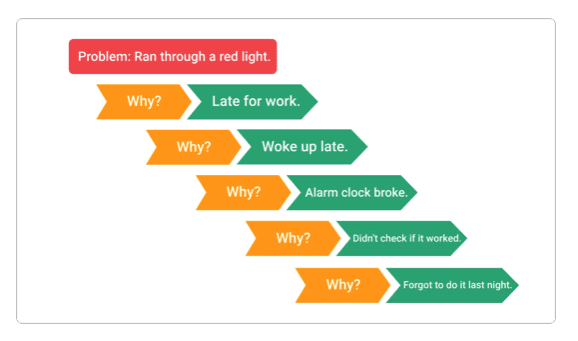A Critique of “5 Whys: The Ultimate Root Cause Analysis Tool”

Are the “5 Whys” The Ultimate Root Cause Analysis Tool?
I don’t usually critique others’ writing, but the headline above (The Ultimate Root Cause Analysis Tool) needed a reply so people don’t follow this bad advice. The article I am critiquing was posted at www.kanbanize.com. Here are the two examples of 5 Whys used in the article to prove how good 5 Whys – the ultimate root cause analysis tool – are…


These examples were listed under the subheading: “5 Whys in Action.”
Critique of the Ultimate Root Cause Analysis Tool
Example 1
Let’s critique Example 1 first. The root cause for running a red light is:
“Forget to do it last night.”
The “it” is checking if the alarm clock worked.
First, how many people check if their alarm clock works every night? I would say no one! I don’t see how this could be a root cause.
I would say that the “alarm clock broke” is a Causal Factor that could be analyzed to find a root cause (or causes). But we don’t have any information about why the alarm clock broke.
The start of this problem is “Ran through a red light.” That is the effect of “Late for Work.” Would you run a red light because you were late for work?
Maybe he ran a pink light (just turned red) because he was in a hurry and judged that he could get through the light on yellow? That poor judgment might be able to be analyzed to find the root cause (or causes).
In other words, this example doesn’t seem to get close to one of the multiple potential root causes for this near-miss. (I’m assuming that running the red light was the worst thing that happened.) We need much more information.
Example 2

First, this really seems like an analysis of why the software updates were late. But let’s go with the newsletter being late (their choice).
This seems a lot like the joke example in this YouTube video…
The root cause found for Example 2 in the article is:
“Because the CTO believes that the new employees don’t
need thorough training, and they should learn while working.”
This doesn’t seem to be a root cause. For example, if new employees are going to learn while working, shouldn’t they allow more time to get the update completed? Doesn’t that question their update schedule?
This example doesn’t appear to give enough details about what happened to start the root cause analysis. Not understanding the complete sequence of events is a frequent problem with 5 Whys. People tend to jump to conclusions. They make that conclusion their fifth why. Then they find four more questions to make their conclusion the root cause.
Want to see more examples of 5 Whys and why they don’t work? CLICK HERE.
Do you want to see why 5 Whys is not the ultimate root cause analysis tool? CLICK HERE.
What is the Ultimate Root Cause Analysis Tool?
If you want to perform advanced root cause analysis (the ultimate root cause analysis) then you should consider finding out more about the fundamentals of root cause analysis and TapRooT® Root Cause Analysis.
First, read this article that compares TapRooT® Root Cause Analysis to 5 Whys:
Another way to know that TapRooT® Root Cause Analysis is effective is this training guarantee:
GUARANTEE
Attend a TapRooT® Root Cause Analysis Course. Go back to work and use what you have learned to analyze accidents, incidents, near-misses, equipment failures, operating issues, or quality problems. If you don’t find root causes that you previously would have overlooked and if you and your management don’t agree that the corrective actions that you recommend are much more effective, just return your course materials and we will refund the entire course fee.
Now the question you should be asking is:
“What TapRooT® Root Cause Analysis Course should I attend?”
To see more about our training, CLICK HERE.
Get advanced root cause analysis training and start finding the real root causes of quality, production, maintenance, safety, environmental, and cost problems. Don’t wait. You can’t afford poor root cause analysis.



